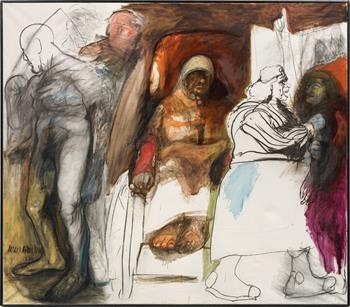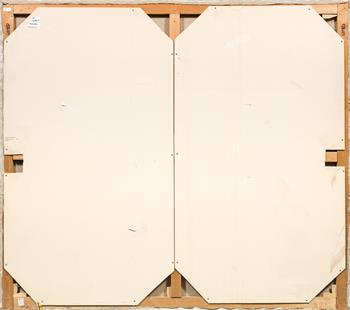0037
Alfred Hrdlicka*
(Wien 1928 - 2009 Wien)
„Countdown“
1974
oil, charcoal, black chalk on canvas; framed
220 x 252 cm
signed and dated on the lower left: Alfred Hrdlicka 1974
Provenance
collection Sanziany & Palais Rasumofsky, Vienna
Literature
Wilhelm Gall. Kunst des 20. Jahrhunderts. collection Reinheimer, Stuttgart 1983, p. 238, ill. p. 175.
Estimate: € 70.000 - 140.000
Result: € 72.550 (incl. fees)
Auction is closed.
With his taboo-free depictions of human abysses, Alfred Hrdlicka went on to become one of the most important artists of Austrian modernism. At the centre of his work is the human being with all his/her facets. Hrdlicka used a realistic vocabulary of forms that combined expressive and figurative elements, thereby taking up counterposition to the abstraction prevalent in the 20th century. One of his most important works is the Mahnmal gegen Krieg und Faschismus (“Memorial Against War and Fascism”) in Vienna city centre. Hrdlicka, who is primarily associated with sculpture, also left behind a significant body of paintings and drawings. At first, he studied painting under Josef Dobrowsky and Albert Paris Gütersloh at the Vienna Academy and later added sculpture studies under Fritz Wotruba.
The large-scale painting Count down from 1974 has its origins in his Randolectil cycle, which he began in 1968 in a variety of media. The name “Randolectil” is taken from a drug used in psychiatry. The motif brings together, from left to right, Melancholy, Hamlet seated, the night nurse and probably Hrdlicka’s first wife Barbara. She may also have been the inspiration for the cycle. She was “sectioned” in closed psychiatric wards due to her mental illness. Hrdlicka had himself admitted to a psychiatric institution at that time in order to study the world of the mentally ill and the treatment methods to which they were subject. His interest centred on the hallucinations of the patients and their depiction. Hrdlicka once put it this way: “I am thus in favour of art that explores delusion, and of course, in a certain sense, also in favour of art that is produced by delusion – but against any endeavour that retouches the clinical picture, subtracts it from the allegedly so creative delusional thinking, and operates with the fata morgana of worthwhile artistic giftedness” (Michael Lewin: Alfred Hrdlicka. Das Gesamtwerk. Schriften, [“Complete works. Writings”] Vienna [i. a.] 1987, p. 21).
(Stefan Üner)



